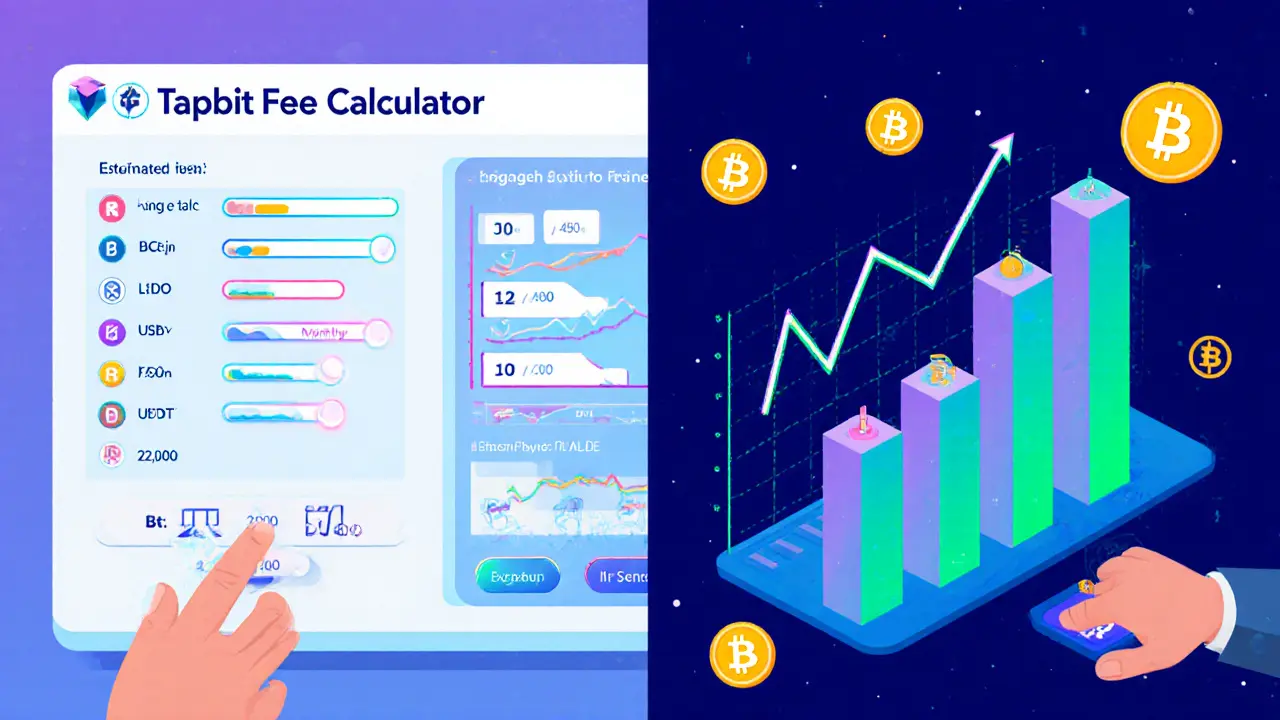Tapbit Crypto Exchange Review 2025: Fees, Security & Liquidity

Tapbit Fee Calculator
Fee Comparison Tool
Compare Tapbit's flat-rate fees with tiered fee structures of major exchanges.
Fee Comparison Results
| Exchange | Spot Fee | Futures Maker | Futures Taker | Annual Savings (vs Tapbit) |
|---|---|---|---|---|
| Tapbit | 0.10% | 0.02% | 0.06% | - |
| Binance | 0.10% - 0.02% | 0.02% | 0.04% | - |
| Coinbase | 0.50% - 0.00% | N/A | N/A | - |
| Kraken | 0.16% - 0.00% | 0.00% - 0.02% | 0.05% - 0.20% | - |
Looking for a fresh crypto broker that promises low fees and a massive list of coins? Tapbit crypto exchange markets itself as the answer, but does it live up to the hype?
TL;DR
- Founded between 2018‑2021, Tapbit offers 700+ coins but most markets suffer thin liquidity.
- Spot fee is a flat 0.1%; futures maker 0.02% / taker 0.06% - low on paper, no volume‑based discounts.
- Leverage up to 150× on USDT‑margined contracts, but limited reserves (≈$184k ETH, $60k BTC) raise slippage risk.
- Security includes 2FA, cold‑hot wallet split, and a claimed $40million insurance fund that lacks independent verification.
- Unregulated in major jurisdictions - treat it as a high‑risk platform and keep exposure modest.
What is Tapbit?
Tapbit is a cryptocurrency exchange and forex brokerage that claims to serve retail and institutional traders in more than 190 countries. The platform reportedly launched in 2018 according to some sources, while others list 2021 as its official start - a discrepancy that already hints at a murky corporate history. Headquartered in the United States, Tapbit advertises access to over 700 digital assets and 500+ trading pairs, positioning itself as a one‑stop shop for spot, futures, copy‑trading and passive‑income products.
Key Products and Services
Tapbit’s product suite mirrors what you’d find on bigger exchanges:
- Spot trading - the core market for buying and selling 700+ coins.
- Futures contracts - USDT‑margined perpetuals with up to 150× leverage.
- Copy trading - follow top performers and replicate their orders automatically.
- Tapbit Earn - a collection of yield‑generating products, from flexible staking to fixed‑term deposits.
The interface is a near‑clone of Binance the world’s largest crypto exchange, known for its clean layout and extensive feature set, which makes the learning curve gentle for traders already familiar with that design. However, several Binance‑style buttons are either disabled or missing, such as the open‑interest widget for futures contracts.
Fee Structure - Numbers That Matter
Tapbit advertises a "flat‑rate" model, meaning you pay the same percentage regardless of volume. That simplicity can be attractive for low‑frequency traders, but high‑volume users lose the tiered discounts you see on Binance or Kraken.
| Exchange | Spot Fee | Futures Maker | Futures Taker | Max Leverage | Regulation |
|---|---|---|---|---|---|
| Tapbit | 0.1% (flat) | 0.02% | 0.06% | 150× (USDT) | Unregulated |
| Binance | 0.10% - 0.02% (tiered) | 0.02% | 0.04% | 125× (USDT) | Some jurisdictions (e.g., Malta) |
| Coinbase | 0.50% - 0.00% (maker‑taker) | N/A | N/A | 5× (margin) | US SEC / FinCEN |
| Kraken | 0.16% - 0.00% (tiered) | 0.00% - 0.02% | 0.05% - 0.20% | 5× | US, EU licenses |
On paper, Tapbit’s 0.1% spot fee looks competitive, but the lack of volume discounts means a professional day trader can end up paying more than on a tiered platform.

Liquidity Reality Check
Liquidity is the lifeblood of any exchange. Tapbit reports access to 700+ assets, yet deep‑order‑book data tells a different story. Roughly 45% of daily volume is concentrated in the ETH/USDT pair and 17% in BTC/USDT. All other markets share the remaining 38%, which translates into thin order books and noticeable slippage for modest orders.
Independent tracking from DeFiLlama shows the exchange’s on‑chain reserves are only about $184k worth of Ethereum and $60k of Bitcoin. Compare that to a major venue like Binance, which holds billions in reserve. The disparity means that a sudden surge in demand for a lesser‑known altcoin could move the price dramatically on Tapbit, even if the same trade would be barely noticeable on a larger platform.
Furthermore, Tapbit claims a 24‑hour BTC perpetual volume of $6.5billion - impressive at a glance - but the exchange does not appear on leading derivatives rankings, raising questions about how that volume is calculated.
Security Measures & the $40Million Insurance Fund
Security is a top‑line concern for crypto traders. Tapbit employs standard industry safeguards:
- Mandatory two‑factor authentication (2FA a second verification step using an app or SMS code).
- Encryption of user data in transit and at rest.
- Segregated cold‑wallet storage for the majority of funds.
- KYC procedures that collect ID documents and proof of address.
Tapbit also touts a $40million insurance fund that supposedly covers user losses from hacking or operational failures. The fund is mentioned in marketing materials, but no third‑party audit or proof of reserve has been published, so traders should treat it as a promotional claim rather than a guaranteed safety net.
Customer Support & User Experience
The platform’s UI feels familiar if you’ve used Binance before - bright charts, quick‑order tabs, and a dark‑mode option. New users find the layout intuitive, but the lack of in‑depth tutorials can be a hurdle for complete beginners. Support channels include email and a live‑chat widget available 24/7; however, there is no phone line, which some traders view as a downside for urgent issues.
Copy‑trading is one of the brighter spots. You can browse a leaderboard of successful traders, allocate a portion of your balance, and let the system auto‑replicate their moves. The feature works well for low‑risk exposure but carries the same leverage risks as direct futures trading - a 150× position can wipe out a small account in seconds if the market swings.
Tapbit Earn offers flexible staking for popular coins (e.g., USDT, BNB) and fixed‑term products with advertised yields ranging from 4% to 12% annualized. Users should read the fine print: yields are variable, and early withdrawal can incur penalties.
Pros & Cons Checklist
- Pros
- Flat‑rate fees simplify cost calculations.
- Wide selection of over 700 coins.
- Copy‑trading and Earn products add passive income options.
- Interface resembles major exchanges, reducing learning curve.
- 2FA, cold storage, and KYC for basic security.
- Cons
- No regulatory license in major jurisdictions.
- Thin liquidity on most alt‑coin pairs, leading to slippage.
- Low on‑chain reserves - $184k ETH, $60k BTC.
- Insurance fund claims lack transparent verification.
- No tiered fee discounts for high‑volume traders.
- Limited educational resources and no phone support.
Should You Trade on Tapbit?
If you’re a hobbyist who wants to dabble in a few niche coins without moving large sums, Tapbit can be a convenient gateway. The low flat fees keep costs predictable, and the copy‑trading dashboard lets you experiment with leveraged strategies without building a market‑analysis setup from scratch.
For serious traders, the platform’s liquidity gaps and lack of regulatory oversight are red flags. A thin order book means you could see 1‑2% price moves on orders that would be negligible elsewhere. Moreover, the unverified insurance fund gives a false sense of safety - you’re still exposed to the same hack or insolvency risks as any unregulated exchange.
My rule of thumb: allocate no more than 5% of your total crypto portfolio to unregulated venues like Tapbit, and keep the bulk on established, licensed exchanges. If you decide to go ahead, start with a small demo account, test the copy‑trading feature, and monitor slippage on each pair before scaling up.

Frequently Asked Questions
Is Tapbit regulated?
No, Tapbit does not hold a license from major financial regulators such as the SEC, FCA, or MAS. Its operations are listed as unregulated, which increases user risk.
How low are the fees compared to Binance?
Tapbit’s flat 0.1% spot fee is similar to Binance’s base rate, but Binance offers tiered discounts that can drop below 0.05% for high volume. Futures taker fees are slightly higher on Tapbit (0.06% vs 0.04% on Binance).
What is the maximum leverage on Tapbit futures?
Up to 150× on USDT‑margined perpetual contracts, though the exact limit can vary by trading pair.
Does the $40million insurance fund protect my assets?
The fund is advertised by Tapbit but has never been audited by a third party. Until an independent verification is provided, the coverage should be considered unconfirmed.
Can I use Tapbit from New Zealand?
Yes, NewZealand is not on Tapbit’s restricted‑country list. Users still need to complete KYC before trading.

15 Comments
Tapbit’s fee structure is pretty straightforward – a flat 0.1% on spot trades and 0.02%/0.06% on futures. That simplicity can be a blessing for casual traders who don’t want to chase volume discounts. However, the thin liquidity on most alt‑coin pairs means you might see noticeable slippage, especially if you’re moving more than a few hundred dollars. The platform does offer 2FA, cold‑wallet storage, and a copy‑trading feature that can be useful for newcomers. All in all, treat it like a sandbox – fun for small experiments, but keep the bulk of your portfolio on a more established exchange.
It is utterly disconcerting that in 2025 we are still witnessing platforms such as Tapbit, which parade themselves as "modern" exchanges, while flagrantly sidestepping the very regulatory frameworks designed to protect unsuspecting retail investors. The absence of a license from any recognized financial authority is not a quirky footnote; it is a glaring red flag that screams irresponsibility and a blatant disregard for the fiduciary duties owed to users. Moreover, touting a $40 million insurance fund without any third‑party audit is nothing more than a marketing ploy, a mirage meant to lull the gullible into a false sense of security. The thin on‑chain reserves – a mere $184 k of ETH and $60 k of BTC – should send shivers down the spine of anyone who values the sanctity of their capital, as they starkly illustrate the platform’s fragility in the face of market turbulence. The leverage offered, soaring up to 150×, is an invitation to ruin, a gambler’s fantasy that transforms modest capital into a burning fuse ready to explode at the slightest price movement. One must also consider the ethical implications of an exchange that permits anonymous trading yet demands KYC only as a perfunctory step, effectively endorsing a dual‑track system that caters to both legitimate users and those intent on evading scrutiny. The copy‑trading feature, while seemingly innovative, further amplifies risk by enabling inexperienced traders to blindly mirror the actions of others, potentially amplifying systemic vulnerabilities. In an ecosystem where trust is paramount, the lack of transparent audits, the absence of regulatory oversight, and the seductive yet perilous promise of high leverage coalesce into a toxic brew that endangers not only individual investors but the broader market integrity. Therefore, engaging with Tapbit is not merely a financial decision; it is an ethical stance that either perpetuates or repudiates the erosion of standards that once underpinned the crypto promise of empowerment and safety.
Ah, dear altruist, you have once again donned the mantle of moral crusader, wielding the sword of righteous outrage against a platform that merely seeks to provide an alternative pathway for market participation!; Yet, let us not forget that every exchange, be it Binance, Coinbase, or the humble Tapbit, operates within the same mercurial realm of risk and reward; ; The notion that absence of a "major" regulator absolves a service of all culpability is, in itself, a philosophical paradox, much like proclaiming that a ship without a captain is inherently safer because no one can steer it into danger; ; While your fervent admonitions echo loudly, the pragmatic trader understands that liquidity, insurance, and leverage are quantifiable variables, not mere moral absolutes; ; Therefore, before casting the final judgment, perhaps a balanced assessment of one’s own risk tolerance would serve better than an unwavering litany of ethical condemnation.
Hey folks, just wanted to add a quick note about the user experience on Tapbit. The UI feels familiar if you’ve used Binance before, which helps speed up onboarding. I’ve found the live‑chat support fairly responsive, though it can get busy during peak hours. The copy‑trading dashboard is intuitive, and you can set allocation limits to manage risk. Overall, for someone looking to dip a toe into niche coins without a steep learning curve, it’s a decent stop‑gap.
Oh, the sweet melodrama of an “unregulated” exchange promising a $40 million safety net – it’s practically a sitcom plotline. You see, the deeper you dig, the more you realize the typical corporate spin: they whisper about insurance while silently hoping you won’t glance at the fine print. Meanwhile, behind the polished UI, shadowy servers probably barter your data for a slice of that non‑existent fund. The whole thing reeks of a grand illusion, a conjured fortress built on the flimsiest of sand‑castles, ready to collapse the moment a logical mind questions the lack of audits.
From a theoretical standpoint, the risk premium associated with an exchange lacking robust custodial reserves can be modeled as a function of the probability of systemic failure multiplied by the exposure of the average user. In practical terms, this translates to an elevated chance of capital erosion under stress scenarios. Moreover, the leverage ceiling of 150× introduces a non‑linear amplification of market volatility, effectively converting modest price swings into catastrophic drawdowns for the under‑collateralized trader. Consequently, a prudent allocation strategy would recommend limiting exposure on such platforms to a small, experimental fraction of one's total portfolio.
So Tapbit says 150× leverage, but with that tiny ETH reserve they’re basically selling tickets to a roller coaster with no brakes – enjoy the ride while it lasts.
Looks like a decent option for dabblers.
Hey everyone! Just a quick reminder: when you’re testing out a new exchange, start with the smallest possible position. Even if the platform looks solid, the combination of high leverage and thin order books can turn a tiny mistake into a big loss. Use the copy‑trading feature cautiously – allocate only a fraction of your capital and keep an eye on the underlying strategy’s performance. And remember, diversification isn’t just about assets, it’s also about where you store them. Happy trading!
It is advisable to approach any emerging exchange with a measured allocation strategy. Begin by allocating no more than five percent of your total crypto holdings, and monitor execution quality over several trading sessions. Should the slippage remain within acceptable bounds, incremental increases may be justified. Nevertheless, continual vigilance is paramount.
Just tried the spot market on Tapbit – the interface is clean and orders went through quickly. No major issues so far.
While the platform’s superficial polish might entice newcomers, the underlying deficiencies-such as inadequate liquidity, unverifiable insurance claims, and the absence of regulated oversight-render it, in my estimation, a precarious choice for anyone with even a modest stake in the market.
Just wanted to share a quick tip: if you decide to use Tapbit’s Earn products, make sure you read the lock‑up terms carefully. Early withdrawal penalties can eat into the advertised yields, and the variable nature of the returns means they’re not guaranteed. Stay informed and keep your risk exposure low.
Of course, the “insurance fund” they brag about is probably just a line in a spreadsheet. The whole operation feels like a covert experiment run by people who think they can outsmart regulators by hiding behind vague statements. Don’t be fooled by the glossy website; behind the scenes it’s likely a hub for money laundering and data harvesting.
In summary, any decision to allocate funds to an unregulated exchange should be accompanied by thorough due‑diligence, a clear understanding of the associated risks, and a disciplined approach to position sizing.